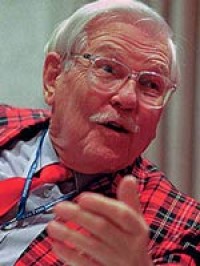Ed Arnold (1913-2007)

TAKEAWAY: Ed Arnold emphasized functionality his entire career; his famous axioms remain intact
It’s Father’s Day, so my best wishes to all the fathers. I’ll spend the day in Tampa, Florida, with my four children and nine grandchildren (number 10 is on the way!).
It is a good day to remember the late Professor Edmund C. Arnold, who passed away in 2007 at age 93. Only last week, a publisher in Latin America, whose newspaper is about to face the competition of a start up free newspaper, asked me in an email: What do you think Ed Arnold would say about today’s free newspapers?
I am sure that Ed formed an opinion about free newspapers, since he died less than a year ago and free newspapers, especially all the Metros—-more than 50 already—-have been around for almost a decade.
From my perspective, and trying to recapture the Ed Arnold I knew, I think he would have plenty to say about free newspapers. I can see him straightening his customary bow tie, then launching into an eloquent discussion: he had a lifetime passion for all things newspaper, so I believe he would think it is a good thing that new newspapers are born everywhere, exposing more readers, and especially young ones, to the joys of newspaper reading.
He would say they are functional and easy to read, aimed at a specific audience of commuters, non newspaper readers and tailored to be read during one’s commute to work.
Functionality was a theme of Ed Arnold’s work and always present in his books, one of which was titled Functional Newspaper Design (1956), which I read in high school. It was one of the first books that I read in my new language, English, and I still remember reading it with a dictionary by my side.
His Arnold Axioms became legend for two generations of editors, publishers and designers. Journalism professors made their students memorize those axioms. One axiom in particular continues to be a sort of unspoken rule with editors everywhere: keep the lead story of the day on the right hand side of the front page.
Ed emphasized functionality in everything he did.
I remember when we met at an American Press Institute design seminar in the early 1980s. We both arrived much earlier than the 9 am starting time for the seminar, and I was experiencing difficulties with my slides and a slide projector.
“Young man,” he said, “don’t ever trust audio visual equipment. It is better to come prepared to speak without any slides or such, just make your message clear, and use the chalkboard if you need to make a graphic point.”
Well said.
To this day, when I experience technical difficulties during a presentation, I see Ed’s smiling face, and his imposing moustache, looking at me, one finger up in the air: I told you so.
.Another true Arnold Axiom to keep in mind.
